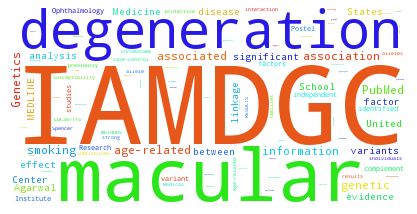Publications
Investigating the Modulation of Genetic Effects on Late AMD by Age and Sex: Lessons Learned and Two Additional Loci.
Winkler TW, et al.
PLoS One. 2018 Mar 12;13(3):e0194321. doi: 10.1371/journal.pone.0194321
PMID:29529059
A Large Genome-Wide Association Study of Age-Related Macular Degeneration Highlights Contributions of Rare and Common Variants.
Fritsche LG, et al.
Nat Genet. 2016 Feb;48(2):134-43. doi: 10.1038/ng.3448
PMID:26691988
Phenotypes
- Age-related macular degeneration
Subjects
Cases: 16,144 subjects of European ancestry with advanced age-related macular degeneration
- 3,235 subjects had geographic atrophy (GA) in at least one eye and no evidence of choroidal neovascularisation (CNV) in any eye
- 10,749 subjects had CNV in at least one eye
- 2,160 subjects had CNV in at least one eye and GA in at least one eye and both eyes affected
Controls: 17,832 subjects of European ancestry
Project

The International Age-related Macular Degeneration Genomics Consortium (originally the AMD Gene Consortium) was formed in early 2010 by 18 research groups from across the world, with support from the National Eye Institute, in order to analyze the genetic architecture of age-related macular degeneration.
Experiment summary
This dataset includes results from two genome-wide association studies: an IAMDGC study of 16,144 late AMD cases and 17,832 controls for age-related macular degeneration (Fritsche et al. 2016, see above), and an age- and sex-stratified study of the same subjects, from Winkler et al. 2018. Younger AMD cases were defined as ≤ 77.8 years old, and older cases were defined as > 77.8 years old. Younger controls were defined as ≤ 71.0 years old, and older controls were defined as > 71.0 years old.
